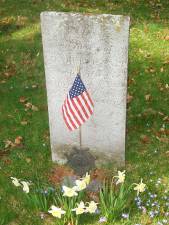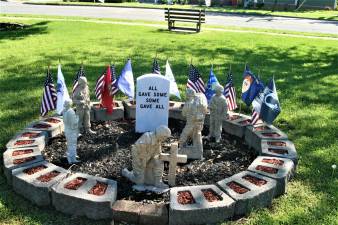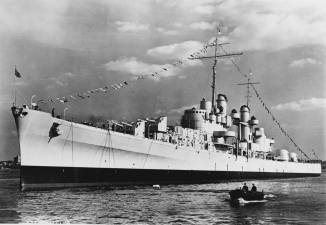A look at West Milford’s Memorial Day traditions and the American Legion

People in the Township of West Milford have been observing Memorial Day with a program and parade for over 75 years. The parade traditionally has followed a solemn service to remember those who died fighting to preserve the nation and its freedoms. The late township/school board attorney Louis Wallisch Jr. initiated the idea for the first observance in 1944. Wallisch encouraged and helped the local veterans’ groups – The Frank M. Sell American Legion Post 289 and Veterans of Foreign Wars Post 7198 – plan and make the event happen.
The traditional observance continues Monday, May 30 at 10 a.m. when West Milford High School musicians will be playing music at Veterans Park. A memorial ceremony will be held at the veteran’s monument, followed by the parade. The marchers travel a route from Union Valley Road, down Marshall Hill Road to Lincoln Avenue to the West Milford American Legion Post 289 building.
The parade route originally started at the corner of Union Valley and Macopin roads. Participants systematically joined in after the first contingent stepped off. The marchers proceeded along Union Valley Road past the town hall, which then was the former Methodist Episcopal Church building and is now the West Milford Museum. A reviewing stand was set up in front of that building. The current municipal building was not built until later in the 1950s.
The late Robert (Bob) Goebel, a former president of the Veterans Council, remembered the year that the first parade was held. Goebel and his father lived in the Pinecliff Lake community. His father had been one of the original cameramen when entertainment movie filming began. His son inherited his dad’s talent with the camera. Popular at the time was the speed graphic – an instrument with plates and large bulbs that produced 4-by-5-inch negatives. Goebel took photos of the parade and was always generous in sharing them. He was an exceptional teacher – who generously helped a 12-year-old kid with her own speed graphic learn how to best use it.
Goebel’s input into those earliest parades made them memorable. He stressed the position of bands so that everyone marching could hear and relate to the music as it was played. In the beginning Goebel and others planning the event had to hire a marching band from the Sussex County town of Franklin. Goebel said West Milford “had to pay cash on the barrel” to get them to travel to West Milford to provide parade music. Sometimes in the early days, a band from Greenwood Lake, NY, with musicians dressed in flashy green and white uniforms, participated in the township event.
The first West Milford town parade could not begin until 1 p.m. because the Franklin band had to march at their own parade in Franklin Borough in the morning. West Milford did not have its own high school or a high school band until many years later. Musical West Milford students were in the Butler High School band that confined its music to the Butler area and a few other Morris County towns.
In 1959 West Milford Mayor Chester Pulis asked the newly formed Veterans Council to plan and produce the parade. They did so until the early 1970s when the Veterans Council members asked the township to appoint a parade committee. Officials reacted by asking them to continue to oversee the event, and they continue to do so.
The parade route changed in the 1960s. The new march started at the town hall and proceeded a short distance to the West Milford Lakes Clubhouse (destroyed by heavy snow falling through the roof a decade or so ago) and then it turned around and proceeded into the Pinecliff Lake community. The tail end of the parade was still moving down Union Valley Road when the beginning was coming from behind the bank (the area where Lakeland Bank is now located), which was Mitchell’s Tavern. The two ends met and caused a gridlock.
It was about 1973 when the town rerouted the parade to proceed from the municipal building to the American Legion Hall on Lincoln Avenue. Since veterans here today say they have no idea who Frank M. Sell was, they choose to now refer to the post as West Milford American Legion Post 289.
For those who may wonder about Frank M. Sell, he was a sailor from the township’s Echo Lake community during World War II. He was serving on the U.S. Navy Atlanta-Class light cruiser Juneau (CL-52) when it was torpedoed in the Pacific Ocean during the Naval Battle of Guadalcanal on Nov. 13, 1942. There were only 10 survivors from the 687-man crew and Frank Sell was not one of them. There were five Sullivan brothers serving on the ship who also went down with it. (A film “The Sullivans” was made about them.) The home where Frank M. Sell grew up is privately owned at the corner of Maple and Macopin roads without any recognition of the hero who grew up there. Sell’s mother, Mildred, was a widow and supported her family by having a tavern business in the house that still is there. The Sells were part of the congregation at St. Joseph Church.
Former Councilman Pete Gillen remembers going to the popular local watering hole – “Sell’s Tavern” with his father. Gillen also remembers when young Frank M. Sell started working to help his family. He was a delivery boy for the Little family’s general store in Newfoundland. The Littles delivered meat, vegetables and other items to homes throughout the township in a converted bus, giving residents the earliest home weekly delivery service at a time when most women did not drive cars and getting to a market was difficult. The late Gene Richards, Joe Bender, Ray Michelfelder and others started the American Legion Post and named it in memory of Frank M. Sell.


